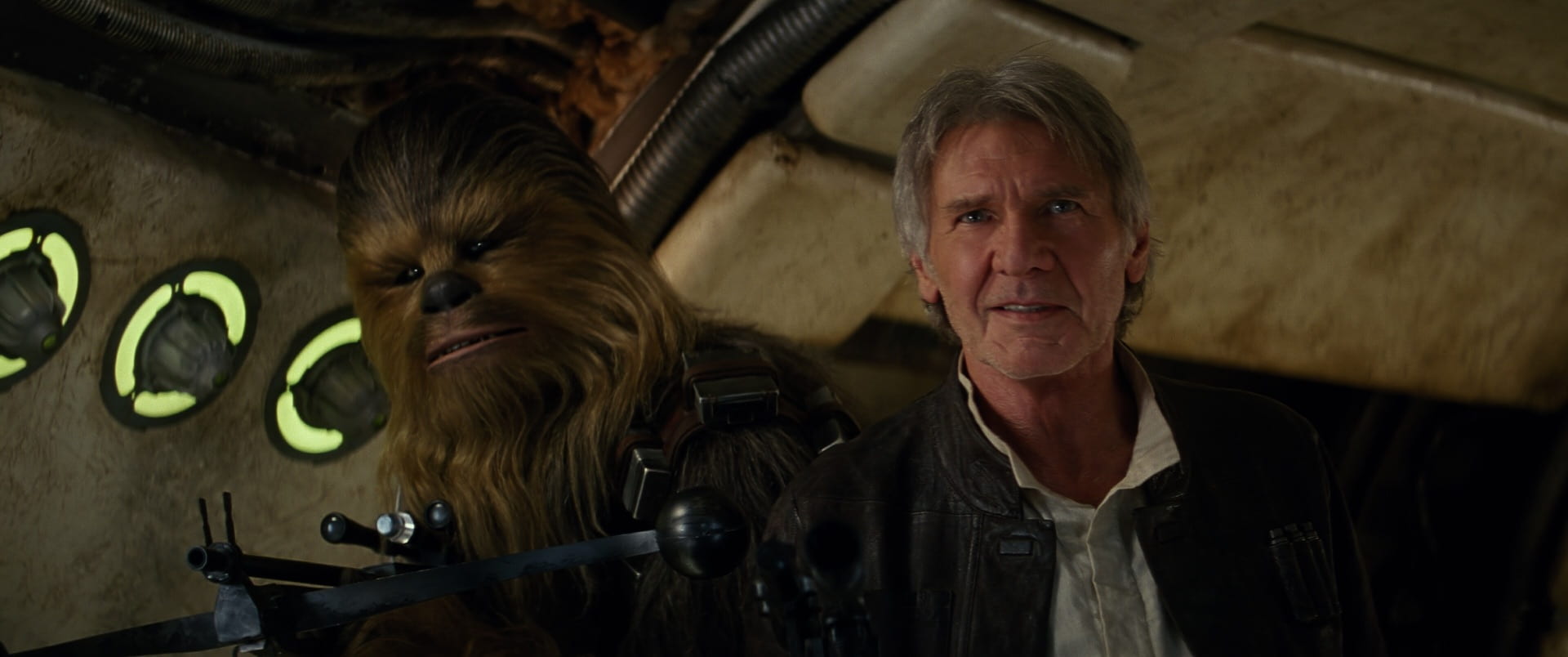
Han and Chewie in Star Wars – Episode VII: The Force Awakens
The first online mention of the legacyquel came in the form of Matt Singer’s article “Welcome to the Age of the Legacyquel.” It was written in response to the Star Wars Episode VII: The Force Awakens’ first full trailer, and Singer begins by writing that “It’s rare for a movie trailer to give [him] chills. But the trailer for Star Wars: The Force Awakens did.”[i] As paratexts for films, trailers aren’t often the subject of much consideration other than the brief bursts of excitement or dread they invoke within their watchers, sometimes expressed as hyperbolic responses in twitter threads or reddit posts. However, as the industry has moved toward not only the kinds of big-budget movies that are preceded by a half-dozen different trailers but also the kinds of franchise-driven decision-making that makes trailers a key paratext to position the film among an ever-expanding constellation of tie-ins and off-shoots, the trailer becomes a key part of the marketing and even creative output in relation to the movie it is advertising. Legacyquel trailers in particular become a crucial part of the audience’s understanding of the films they advertise as they aim to both reignite the fan-ish feelings audience members have or had about the previous entries in the franchise while they also try to draw in new audience members promising an experience that is in line with modern filmmaking styles and concerns.
Lisa Kernan reminds us that in addition to their advertising function trailers “are also a unique form of narrative film exhibition, wherein promotional discourse and narrative pleasure are combined.”[ii] Indeed, the stories film trailers tell are oddly among the industry’s most popular, far outreaching the actual audience for any given film. Their twofold job, to sell a filmic experience and to do so by providing, however misleading, a bite-sized version of that experience and story, makes them a vital location for understanding how Hollywood conceives of their products and the audiences to whom they sell that product.
Following Kernan and using her framework, I will examine the “unique and specific rhetorical structures that fold visual and auditory evidence of the film production industry’s assessment of its actual audience (as well as its desires for a potential audience”[iii] in legacyquel trailers, particularly her understanding of the “three principal textual features of films: genres, stories, and stars” within the additional constraints and affordances of the legacyquel storytelling tropes. Each of these three elements of film trailers gains an extra valence of nostalgic energy within legacyquel trailers as their editors work to blend old audiences with the new. As Kernan notes, “Different markets are made visible in trailers by textual evidence of ‘targeting,’ or appeals to specific genders, age groups, or other categories of subjectivity within trailers’ overall mission to expand the audience.”[iv] In the trailers for legacyquels those targeted appeals are balanced between reminding existing fans of their attachment to the story, characters, and actors involved in the series prior to the new entry and exciting potential new audience members with the promise of an intelligible entrypoint into the franchise usually through the method of new, younger stars/characters, often in the form of a more diverse cast than previous entries as well. This diversity appeals to the desire in current audiences to see a broader representation of races, genders, and sexualities on screen, especially in the blockbuster spaces where characters of minoritized backgrounds were often absent or shunted to sidekick and love interest roles. (INSERT REFERENCE TO BLOCKBUSTER BOOK HERE). Like the movies they are made to sell, legacyquel trailers speak to a dual audience and sell the promise of a newer, more diverse vision of the franchise they are attached to while promising that things haven’t changed too much via the presence of the older characters and their returning actors.
[i] Singer, Matt. “Welcome to the Age of the Legacyquel.” Media Journalism. Screen Crush, November 23, 2015. https://screencrush.com/the-age-of-legacyquels/.
[ii] Kernan, Lisa. Coming Attractions: Reading American Movie Trailers. Texas Film and Media Series. Austin: University of Texas Press, 2004, 1.
[iii] Ibid., 3.
[iv] Ibid., 14-15.